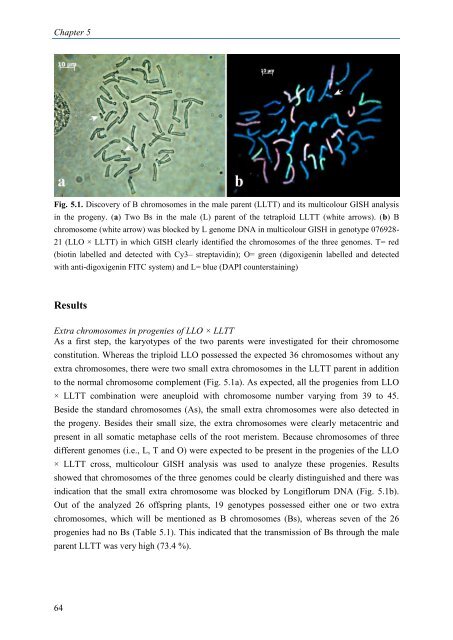A molecular cytogenetic analysis of chromosome behavior in Lilium ...
A molecular cytogenetic analysis of chromosome behavior in Lilium ...
A molecular cytogenetic analysis of chromosome behavior in Lilium ...
You also want an ePaper? Increase the reach of your titles
YUMPU automatically turns print PDFs into web optimized ePapers that Google loves.
Chapter 5Fig. 5.1. Discovery <strong>of</strong> B <strong>chromosome</strong>s <strong>in</strong> the male parent (LLTT) and its multicolour GISH <strong>analysis</strong><strong>in</strong> the progeny. (a) Two Bs <strong>in</strong> the male (L) parent <strong>of</strong> the tetraploid LLTT (white arrows). (b) B<strong>chromosome</strong> (white arrow) was blocked by L genome DNA <strong>in</strong> multicolour GISH <strong>in</strong> genotype 076928-21 (LLO × LLTT) <strong>in</strong> which GISH clearly identified the <strong>chromosome</strong>s <strong>of</strong> the three genomes. T= red(biot<strong>in</strong> labelled and detected with Cy3– streptavid<strong>in</strong>); O= green (digoxigen<strong>in</strong> labelled and detectedwith anti-digoxigen<strong>in</strong> FITC system) and L= blue (DAPI countersta<strong>in</strong><strong>in</strong>g)ResultsExtra <strong>chromosome</strong>s <strong>in</strong> progenies <strong>of</strong> LLO × LLTTAs a first step, the karyotypes <strong>of</strong> the two parents were <strong>in</strong>vestigated for their <strong>chromosome</strong>constitution. Whereas the triploid LLO possessed the expected 36 <strong>chromosome</strong>s without anyextra <strong>chromosome</strong>s, there were two small extra <strong>chromosome</strong>s <strong>in</strong> the LLTT parent <strong>in</strong> additionto the normal <strong>chromosome</strong> complement (Fig. 5.1a). As expected, all the progenies from LLO× LLTT comb<strong>in</strong>ation were aneuploid with <strong>chromosome</strong> number vary<strong>in</strong>g from 39 to 45.Beside the standard <strong>chromosome</strong>s (As), the small extra <strong>chromosome</strong>s were also detected <strong>in</strong>the progeny. Besides their small size, the extra <strong>chromosome</strong>s were clearly metacentric andpresent <strong>in</strong> all somatic metaphase cells <strong>of</strong> the root meristem. Because <strong>chromosome</strong>s <strong>of</strong> threedifferent genomes (i.e., L, T and O) were expected to be present <strong>in</strong> the progenies <strong>of</strong> the LLO× LLTT cross, multicolour GISH <strong>analysis</strong> was used to analyze these progenies. Resultsshowed that <strong>chromosome</strong>s <strong>of</strong> the three genomes could be clearly dist<strong>in</strong>guished and there was<strong>in</strong>dication that the small extra <strong>chromosome</strong> was blocked by Longiflorum DNA (Fig. 5.1b).Out <strong>of</strong> the analyzed 26 <strong>of</strong>fspr<strong>in</strong>g plants, 19 genotypes possessed either one or two extra<strong>chromosome</strong>s, which will be mentioned as B <strong>chromosome</strong>s (Bs), whereas seven <strong>of</strong> the 26progenies had no Bs (Table 5.1). This <strong>in</strong>dicated that the transmission <strong>of</strong> Bs through the maleparent LLTT was very high (73.4 %).64














